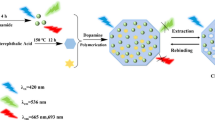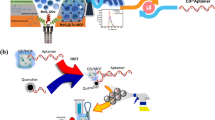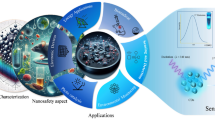Abstract
In this paper, a novel and selective fluorescent probe for nanocomposite materials were developed by in situ growth carbon quantum dots (CQDs) in the channel of mesoporous silica nanospheres (MSNs) for the detection of tetracycline (TC). The CQDs@MSNs nanocomposites were prepared via a facile hydrothermal method. The CQDs incorporated into MSNs can act as the low-toxicity and stable fluorescent probes for the detection of TC. Under optimal conditions, a fluorescence emission peak at 439 nm was observed for the CQDs@MSNs when the excitation wavelength was set as 360 nm, and the fluorescence peak intensity can be gradually quenched by TC via inner filter effect, a good linear relationship between the concentration of TC from 0 to 100 μM, and the fluorescence quenching intensity of CQDs@MSNs was obtained, with a limit detection of 5.19 μM. More importantly, the CQDs@MSNs have been successfully used for TC determination in real samples.









Similar content being viewed by others
Data availability
The authors confirm that the data supporting the findings of this study are available within the article.
References
Z. Liu, J.Z. Hou, X.F. Wang, C.J. Hou, Z. Ji, Q. He, D. Hou, A novel fluorescence probe for rapid and sensitive detection of tetracyclines residues based on silicon quantum dots. Spectrochim. Acta A 240, 118463 (2020)
M.C. Carson, M.A. Ngoh, S.W. Hadley, Confirmation of multiple tetracycline residues in milk and oxytetracycline in shrimp by liquid chromatography–particle beam mass spectrometry. J. Chromatogr. B 712, 113–128 (1998)
A.K. Sarmah, M.T. Meyer, A.B. Boxall, A global perspective on the use, sales, exposure pathways, occurrence, fate and effects of veterinary antibiotics (VAs) in the environment. Chemosphere 65, 725–759 (2006)
L.A. Cox, D.A. Popken, Assessing potential human health hazards and benefits from subtherapeutic antibiotics in the United States: tetracyclines as a case study. Risk Anal. 30, 432–457 (2010)
J. Hu, X. Yang, Q. Peng, F. Wang, Y. Zhu, X. Hu, B. Zheng, J. Du, D. Xiao, A highly sensitive visual sensor for tetracycline in food samples by a double-signal response fluorescent nanohybrid. Food Control 108, 106832 (2020)
S. Wang, J. Liu, W. Yong, Q. Chen, L. Zhang, Y. Dong, H. Su, T. Tan, A direct competitive assay-based aptasensor for sensitive determination of tetracycline residue in honey. Talanta 131, 562–569 (2015)
R. Wei, F. Ge, S. Huang, M. Chen, R. Wang, Occurrence of veterinary antibiotics in animal wastewater and surface water around farms in Jiangsu Province, China. Chemosphere 82, 1408–1414 (2011)
C. Blasco, A.D. Corcia, Y. Picó, Determination of tetracyclines in multi-specie animal tissues by pressurized liquid extraction and liquid chromatography–tandem mass spectrometry. Food Chem. 116, 1005–1012 (2009)
G. Mu, H. Liu, L. Xu, L. Tian, F. Luan, Matrix solid-phase dispersion extraction and capillary electrophoresis determination of tetracycline residues in milk. Food Anal. Methods 5, 148–153 (2011)
C. Shi, H. Qi, R. Ma, Z. Sun, L. Xiao, G. Wei, Z. Huang, S. Liu, J. Li, M. Dong, J. Fan, Z. Guo, N, S-self-doped carbon quantum dots from fungus fibers for sensing tetracyclines and for bioimaging cancer cells. Mater. Sci. Eng. C 105, 110132 (2019)
J. Wang, R. Cheng, Y. Wang, L. Sun, L. Chen, X. Dai, J. Pan, G. Pan, Y. Yan, Surface-imprinted fluorescence microspheres as ultrasensitive sensor for rapid and effective detection of tetracycline in real biological samples. Sens. Actuators B 263, 533–542 (2018)
S. Safari, A. Amiri, A. Badiei, FRET probe for selective and sensitive detection of vitamin A by cadmium free quantum dots (ZnS). Spectrochim. Acta A 231, 118062 (2020)
J. Chen, A. Xiao, Z. Zhang, Y. Yu, Z. Yan, The synthesis and modification of CdTe/CdS core shell quantum dots. Spectrochim. Acta A 151, 506–509 (2015)
Y. Yang, Y. Chang, Y. Guo, L. Yu, G. Zhang, D. Zhai, X. Wang, X. Sun, Fluorometric microplate-based dimethoate assay using CdSe/ZnS quantum dots coated with a molecularly imprinted polymer. Mikrochim. Acta. 186, 589 (2019)
B.Y. Yang, Y.Q. Zhang, Q.D. Zhang, Y.H. Liu, Y. Yan, Study on the preparation of water-soluble AgInS2 quantum dots and their application in the detection of ciprofloxacin. J. Mater. Sci.: Mater. Electron. 30, 18794–18801 (2019)
J.Z. Chen, H.Y. Du, Y.F. Xu, B.Y. Ma, Z.H. Zheng, P.C. Li, Y.Q. Jiang, A turn-on fluorescent sensor based on coffee-ground carbon dots for the detection of sodium cyclamate. J. Mater. Sci.: Mater. Electron. 32, 13581–13587 (2021)
Y. Yan, J.H. Liu, R.S. Li, Y.F. Li, C.Z. Huang, S.J. Zhen, Carbon dots synthesized at room temperature for detection of tetracycline hydrochloride. Anal. Chim. Acta 1063, 144–151 (2019)
T. Hao, X. Wei, Y. Nie, Y. Xu, Y. Yan, Z. Zhou, An eco-friendly molecularly imprinted fluorescence composite material based on carbon dots for fluorescent detection of 4-nitrophenol. Microchim. Acta 183, 2197–2203 (2016)
M. Tang, X. Liu, N. Zhang, J. Pang, Y. Zou, F. Chai, H. Wu, L. Chen, Synthesis of nitrogen and sulfur codoped carbon dots and application for fluorescence detection of Cd(ii) in real water samples. Anal. Methods 11, 5214–5221 (2019)
Y. Tu, X. Chen, Y. Xiang, X. Yuan, K. Qin, Y. Wei, Z. Xu, Q. Zhang, X. Ji, Hydrothermal synthesis of a novel mesoporous silica fluorescence carbon dots and application in Cr(VI) and folic acid detection. Nano 15, 2050090 (2020)
H. Lu, D. Wei, R. Zheng, S. Xu, Post-imprinting modification based on multilevel mesoporous silica for highly sensitive molecularly imprinted fluorescent sensors. Analyst 144, 6283–6290 (2019)
Y. Dong, J. Ma, C. Liu, Y. Bao, Ordered mesoporous silica encapsulated carbon quantum dots and its application in Fe3+ detection. Ceram. Int. 46, 11115–11123 (2020)
J. Yang, Z.Z. Lin, A.Z. Nur, Y. Lu, M.H. Wu, J. Zeng, X.M. Chen, Z.Y. Huang, Detection of trace tetracycline in fish via synchronous fluorescence quenching with carbon quantum dots coated with molecularly imprinted silica. Spectrochim. Acta. A 190, 450–456 (2018)
C. Qiu, Y. Xing, W. Yang, Z. Zhou, Y. Wang, H. Liu, W. Xu, Surface molecular imprinting on hybrid SiO2-coated CdTe nanocrystals for selective optosensing of bisphenol A and its optimal design. Appl. Surf. Sci. 345, 405–417 (2015)
P.F. Plinio Innocenzi, Order-disorder transitions and evolution of silica structure in self-assembled mesostructured silica films studied through FTIR spectroscopy. J. Phys. Chem. B 107, 4711–4717 (2003)
B. Wang, F. Liu, Y. Wu, Y. Chen, B. Weng, C.M. Li, Synthesis of catalytically active multielement-doped carbon dots and application for colorimetric detection of glucose. Sens. Actuators B 255, 2601–2607 (2018)
J. Wu, Y. Dong, X. Yang, C. Yao, N-doped carbon dots sensor for selective detection of hydroxylamine hydrochloride. Opt. Mater. 94, 121–129 (2019)
P. Ni, Q. Li, C. Xu, H. Lai, Y. Bai, T. Chen, Optical properties of nitrogen and sulfur co-doped carbon dots and their applicability as fluorescent probes for living cell imaging. Appl. Surf. Sci. 494, 377–383 (2019)
F. Liu, F. Niu, T. Chen, J. Han, Z. Liu, W. Yang, Y. Xu, J. Liu, One-step electrochemical strategy for in-situ synthesis of S, N-codoped graphene as metal-free catalyst for oxygen reduction reaction. Carbon 134, 316–325 (2018)
J. Fu, M. Zhang, L. Jin, L. Liu, N. Li, L. Shang, M. Li, L. Xiao, Y. Ao, Enhancing interfacial properties of carbon fibers reinforced epoxy composites via layer-by-layer self assembly GO/SiO2 multilayers films on carbon fibers surface. Appl. Surf. Sci. 470, 543–554 (2019)
B. Saboorizadeh, R. Zare-Dorabei, N. Shahbazi, Green synthesis of carbon quantum dots and their application as a fluorometric sensor for highly selective determination of 6-mercaptopurine in biological samples. J. Taiwan Inst. Chem. 129, 389–395 (2021)
S. Chandra, D. Bano, K. Sahoo, D. Kumar, V. Kumar, P.K. Yadav, S.H. Hasan, Synthesis of fluorescent carbon quantum dots from Jatropha fruits and their application in fluorometric sensor for the detection of chlorpyrifos. Microchem. J. 172, 106953 (2022)
Z.P. Liu, J.Z. Hou, X.F. Wang, C.J. Hou, Z. Ji, Q. He, D.Q. Huo, A novel fluorescence probe for rapid and sensitive detection of tetracyclines residues based on silicon quantum dots. Spectrochim. Acta A 240, 118463 (2020)
X. Wei, L. Lv, Z.D. Zhang, W.S. Guan, Preparation of molecularly imprinted fluorescence sensor based on carbon quantum dots via precipitation polymerization for fluorescence detection of tetracycline. J. Appl. Polym. Sci. 137, e49126 (2020)
Funding
The work was funded by the Natural Science Basic Research Plan in Shaanxi Province of China (2020JM-221), the National Natural Science Foundation of China (Grant No. 21607013), the Fundamental Research Funds for the Central Universities, CHD (300102310203, 300102311405) and the Collation and Entrepreneurship Project (S202010710207).
Author information
Authors and Affiliations
Contributions
JZ contributed to writing of the original draft, project administration, and funding acquisition. YY contributed to writing of the original draft. KC contributed to writing, reviewing, and editing of the manuscript. JM performed investigation. PY contributed to writing and reviewing of the manuscript.
Corresponding author
Ethics declarations
Conflict of interests
The authors declare that they have no known competing financial interests or personal relationships that could have appeared to influence the work reported in this paper.
Additional information
Publisher's Note
Springer Nature remains neutral with regard to jurisdictional claims in published maps and institutional affiliations.
Rights and permissions
About this article
Cite this article
Zheng, J., Yang, Y., Cheng, K. et al. Mesoporous silica nanoparticles encapsulated carbon quantum dots for detection of tetracycline. J Mater Sci: Mater Electron 33, 17036–17047 (2022). https://doi.org/10.1007/s10854-022-08581-3
Received:
Accepted:
Published:
Issue Date:
DOI: https://doi.org/10.1007/s10854-022-08581-3




